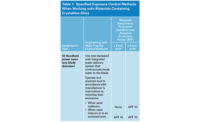The work environment is undergoing a seismic shift, largely driven by technological advancements. From remote work to automation, technology is reshaping how we think about our jobs and workplaces. This evolution presents both opportunities and challenges for Environmental, Health, and Safety (EHS) management.
EHS management is more critical than ever because today's work environments are becoming more and more complex. With diverse work environments and an increasing focus on sustainability and safety, EHS managers are responsible for ensuring that workplaces not only comply with regulations but also remain safe and sustainable.
Technology enhances communication, collaboration, and data-driven decision-making in a connected workforce. This concept is becoming increasingly relevant in EHS management.
The integration of technology into the workplace impacts safety protocols, error margins, environmental policies, and employee well-being. Being well-versed in the connected workforce enables EHS managers to better navigate these complexities.
Benefits of integrating a connected workforce
Enhanced communication
Real-time updates are a cornerstone of a connected workforce. They allow EHS managers to receive immediate notifications about safety incidents or environmental concerns, enabling quick action and potentially preventing accidents.
Efficient reporting mechanisms make it easier for employees to log safety incidents or environmental issues. This streamlined process ensures that concerns are addressed promptly, contributing to a safer and more compliant work environment.
Take S3 Services, for example. As a rapidly growing energy partner, the company needed a more efficient way to report incidents and communicate across the business without dealing with multiple document versions or intermediaries.
The solution came through KPA's EHS software, which eliminated manual tasks and standardized documentation, allowing the company to go paperless. The results were significant cost savings and valuable insights into safety trends, enabling more effective risk mitigation. One of their data analysts described the newfound clarity on safety trends as "incredible."
Data-driven insights
Predictive analytics tools can forecast potential safety hazards based on historical data and current conditions. This enables EHS managers to take proactive measures, thereby reducing the likelihood of accidents occurring.
Data-driven insights also extend to environmental monitoring. EHS managers can track metrics like carbon emissions, waste production, and water usage, helping the company to meet sustainability goals and comply with regulations.
Fostering a culture of collaboration
Interconnected tools and platforms facilitate better teamwork among employees. These technologies make it easier to collaborate on EHS practices, fostering a culture where safety and environmental responsibility are collective efforts.
In a connected workforce, the responsibility for EHS practices is shared among all employees. This collective approach ensures that safety and sustainability are not just the concerns of the EHS department but are integrated into the company culture.
Challenges and risks
Data security
Data security is a significant concern when implementing a connected workforce. Adequate protection of sensitive information, such as employee health records and proprietary data, is the responsibility of EHS managers when implementing a connected workforce.
Compliance with data protection laws is another challenge. Failure to comply can result in legal repercussions, including fines and reputational damage.
As EHS operations become increasingly digitized, they are more susceptible to cyber threats such as malware, phishing, and ransomware attacks. The five key areas of concern include outdated software, remote work vulnerabilities, insecure IoT devices, unrestricted data access, and insider threats. EHS managers should take these concerns as signals to address cybersecurity proactively in their operations.
Employee training
New technologies often come with a learning curve. Employees may be resistant to change, making it challenging for EHS managers to effectively implement new systems.
Resistance to change is a common challenge when introducing new technologies. EHS managers must address this resistance through effective communication and training programs to ensure successful implementation.
Ethical considerations
The use of surveillance technologies can raise ethical concerns. While these tools can enhance safety, they may also infringe on employee privacy, requiring a careful balancing act.
In a connected workforce, the lines between work and personal life can blur. EHS managers must consider the implications of constant connectivity on employees' work-life balance and take steps to mitigate potential issues.
Practical implications for EHS Managers
Here are some important pre- and post-implementation considerations for EHS personnel:
Assessing the current EHS infrastructure: Before implementing a connected worker platform, EHS managers must assess the current infrastructure. This involves identifying gaps and opportunities for improvement, setting the stage for effective integration.
Evaluating technology vendors: Choosing the right technology vendors is crucial for a successful transition to a connected workforce. EHS managers must carefully evaluate potential partners to ensure they align with the company's goals and needs.
Develop a detailed implementation plan: Creating a detailed implementation plan is essential for a smooth transition. This plan should outline the steps and timelines for integrating new technologies, as well as identify potential challenges and solutions.
Monitoring and evaluation: Monitoring the effectiveness of a connected workforce involves the use of Key Performance Indicators (KPIs). These metrics provide measurable outcomes that help EHS managers evaluate the success of their initiatives.
Feedback loops are essential for continuous improvement. EHS managers should establish mechanisms for collecting and analyzing feedback from employees to make necessary adjustments.
Conclusion
A connected workforce offers numerous benefits for EHS management, including enhanced communication, data-driven insights, and a culture of collaboration. However, we must also address challenges such as employee training and data security.
The role of EHS managers is likely to evolve as technology continues to permeate the workplace. Adapting to this new landscape is not just beneficial but essential for future success.
EHS managers should take immediate steps to understand and integrate a connected workforce into their existing systems. This involves assessing the current infrastructure, selecting appropriate vendors, and creating a detailed implementation plan.




